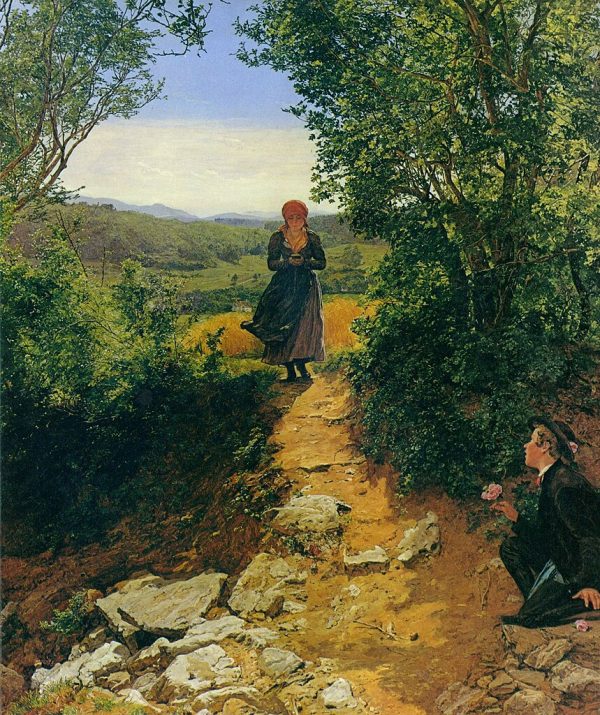Oddities
Double Duty
What’s the greatest number of Fridays that can fall in February? We might say five, imagining a leap year in which February 1 falls on a Friday.
“However, it is possible to reckon double the number of Fridays in the month of February alone,” contends Soviet science writer Yakov Perelman. “Imagine a ship plying between Siberia and Alaska and leaving the Asiatic shore regularly every Friday. How many Fridays will its skipper count in a leap-year February of which the 1st is a Friday? Since he crosses the date line from west to east and does so on a Friday, he will reckon two Fridays every week, thus adding up to 10 Fridays in all.”
“On the contrary, the skipper of a ship leaving Alaska every Thursday and heading for Siberia will ‘lose’ Friday in his day reckoning, with the result that he won’t have a single Friday in the whole month.”
(From Astronomy for Entertainment, 1958.)
History Lesson

In Scranton, Pennsylvania, Washington crosses Delaware.
The Broxburn Icicle
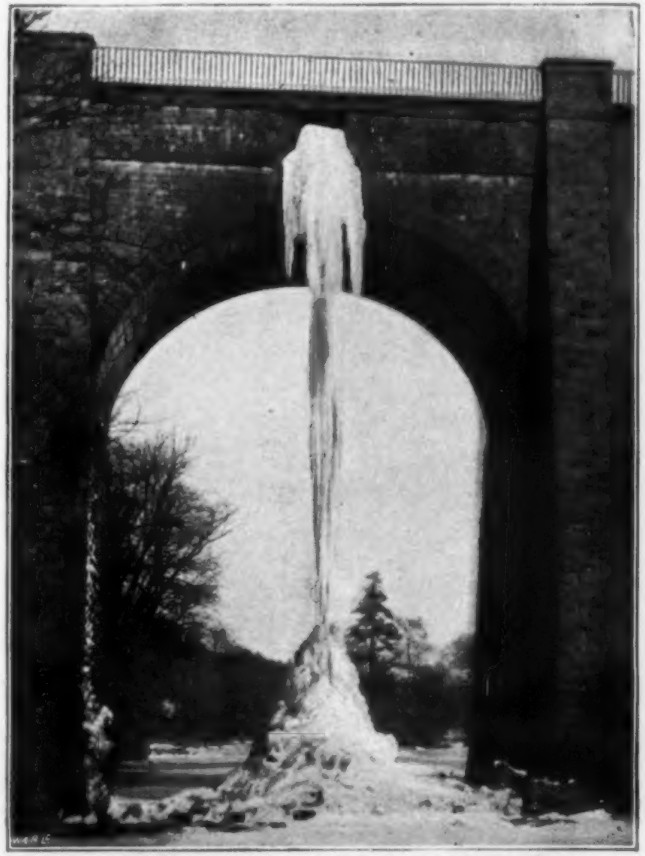
During the severe frost of February 1895, a stream of water overflowing Scotland’s Almond Aqueduct began to freeze to the River Almond 120 feet below. Over the course of three nights the mass grew upward until river and bridge were connected by a continuous pillar of ice, the largest such formation on record at the time.
“When the sun shone upon the giant mass,” observed the Strand, “the iridescence was beautiful, and people came from miles around to look at it.”
(Jeremy Broome, “Freaks of Frost,” Strand 12:12 [December 1896], 738-746.)
Return Engagement

On Easter Saturday 1921, pharmacologist Otto Loewi dreamed of an experiment that would prove that the transmission of nerve impulses was chemical rather than electrical. He scribbled down the idea and went back to sleep, then discovered the next morning that he couldn’t read the note.
That day, he said, was the longest of his life. Fortunately, the dream returned to him that night, and this time he went immediately to the laboratory. Thirteen years later he received the Nobel Prize for discovering the role of acetylcholine as an endogenous neurotransmitter.
The Immortal Bridge
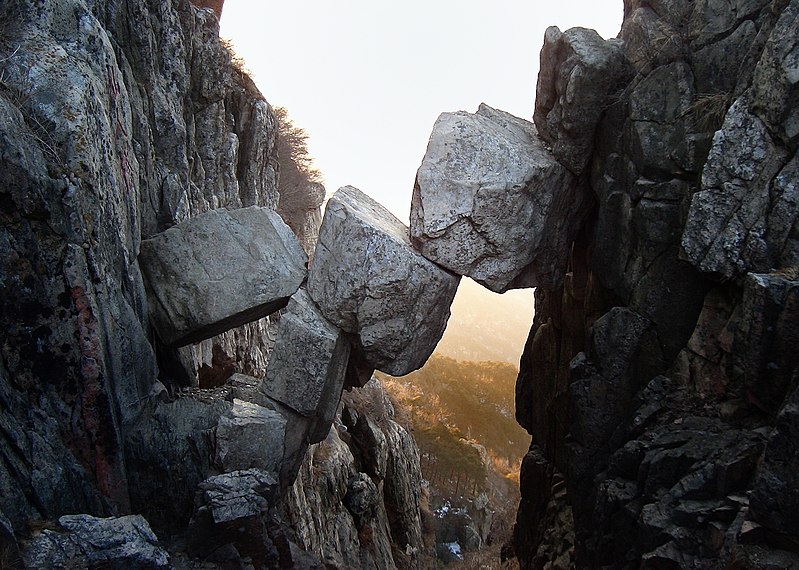
This rock formation, formed possibly thousands of years ago, spans a chasm on Mount Tai, one of the Five Great Mountains of China.
It’s said that anyone who crosses the bridge will live forever.
Andy
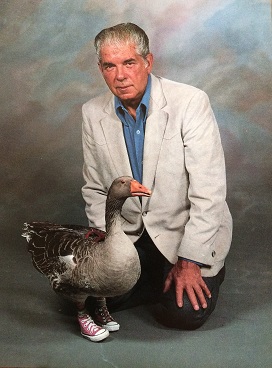
When a goose without feet was hatched in Harvard, Nebraska, in 1987, local inventor Gene Fleming adopted the bird, fitted him with baby-sized shoes, and taught him to walk. In time “Andy” learned to swim and fly as well; he gave inspiration to disabled children and received a lifetime supply of shoes from Nike, but it wasn’t to last — in 1991 he was killed by an unnamed perpetrator.
The Dim Effect
In 2006, German entomologist Jochen-P. Saltin discovered a new species of rhinoceros beetle in Peru, which he dubbed Megaceras briansaltini.
Remarkably, the insect’s horn closely resembles that of Dim, the blue rhinoceros beetle in the Disney film A Bug’s Life, which was released eight years earlier.
“I know of no dynastine head horn that has ever had the shape of the one seen in M. briansaltini, and so its resemblance to a movie character seems like a case of nature mimicking art … or what could be referred to as ‘the Dim Effect,'” wrote entomologist Brett C. Ratcliffe.
“There are numerous examples of art mimicking nature (paintings, sculpture, etc.), but that cannot be the case here, because there had never been a known rhinoceros beetle in nature upon which the creators of Dim could have used as a model for the head horn. In my experience, then, Dim was the first ‘rhinoceros beetle’ to display such a horn, and the discovery of M. briansaltini, a real rhinoceros beetle, came later.”
(Brett C. Ratcliffe, “A Remarkable New Species of Megaceras From Peru [Scarabaeidae: Dynastinae: Oryctini]. The ‘Dim Effect’: Nature Mimicking Art,” The Coleopterists Bulletin 61:3 [2007], 463-467.)
Cameo

In his Schilderboeck of 1604, Flemish artist Karel van Mander writes that his contemporary Marcus Gheeraerts the Elder is a good landscape painter who “often had the habit of including a squatting, urinating woman on a bridge or elsewhere.”
None of Gheeraerts’ landscapes are known to survive, but we have a perspective map of his native Bruges that he completed in 1562 and … there she is.
Feats
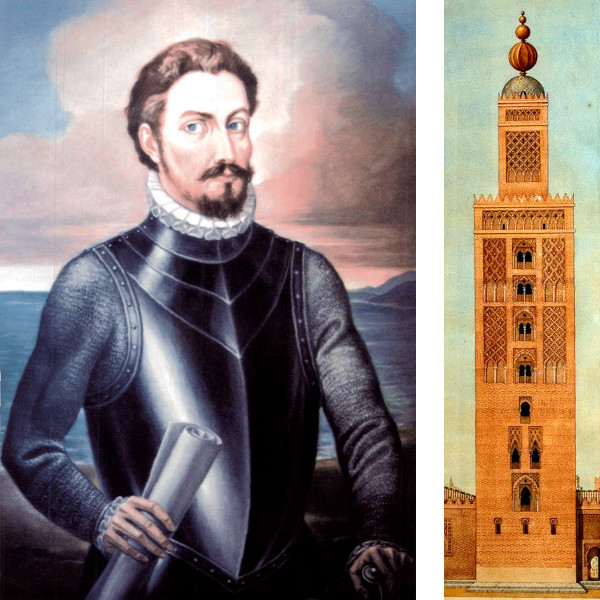
Commons
This just caught my eye — a feat attributed to the Spanish explorer Alonso de Ojeda, who would later accompany Columbus and name Venezuela:
Queen Isabella being in the tower of the cathedral at Seville, better known as the Giralda, Ojeda, to entertain her majesty, and to give proofs of his courage and agility, mounted on a great beam which projected in the air, twenty feet from the tower, at such an immense height from the ground, that the people below looked like dwarfs, and it was enough to make Ojeda himself shudder to look down. Along this beam he walked briskly, and with as much confidence as though he had been pacing his chamber. When he arrived at the end, he stood on one leg, lifting the other in the air; then turning nimbly round, he returned in the same way to the tower, unaffected by the giddy height, whence the least false step would have precipitated him and dashed him to pieces.
Allegedly he afterward threw an orange to the top of the tower, which would have been at least 88 meters tall at the time. This account is from Washington Irving’s biography of Columbus, and even Irving calls it “unworthy of record, but that it exhibits the singular character of the man.”
Emerson mentions Ojeda’s balancing act in his 1870 essay on success, claiming also that “Olaf, king of Norway, could run round his galley on the blades of the oars of the rowers when the ship was in motion.” I’m not even pursuing that one.
06/12/2024 UPDATE: Apparently oar-walking is not as far-fetched as it sounds. While the feat is rare, it is said that King Olafr Tryggvason did indeed run on the oar blades of his ship the Long Serpent as it was being rowed. Kirk Douglas manages the feat pretty well in the 1958 film The Vikings (thanks, Orion):

